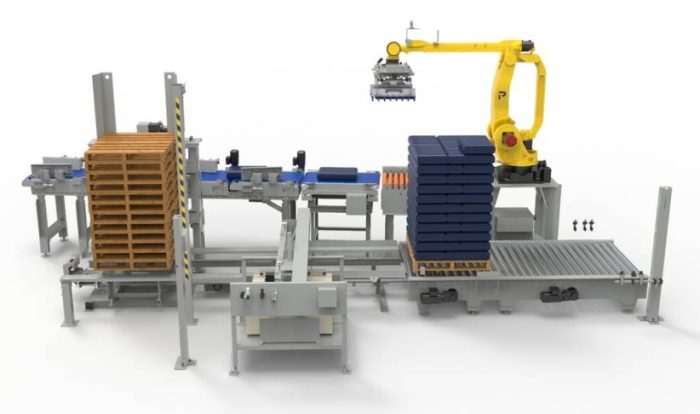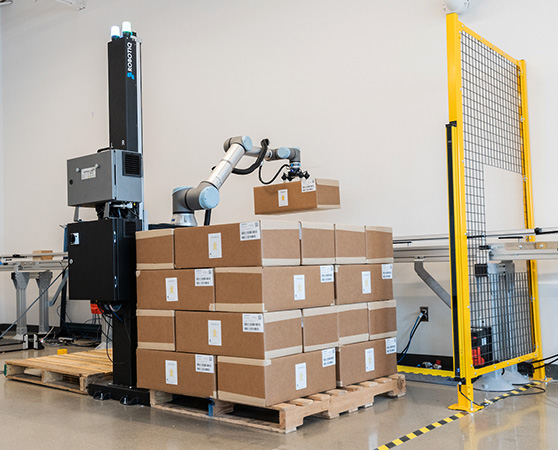Palletizing: Analyzing Your Operation
What type of palletizer do you need...and why do you need it? A breakdown of ROI and spec factors

Automated palletizing is one of the best places to target automation because the process is so manual and heavy duty for many companies.
Why? Because it helps you reduce one of the least value-add parts of your operation: stacking and creating pallets. Doing that manually makes less sense every passing year for companies that are already working to reduce dependency on an ever-contracting labor pool. To get the process started, start by focusing on your operational needs, customer base and labor factors.
The business case for palletizing
Palletizing options, whether conventional layer style, fully automated robotic, or cobot alternatives, can be expensive, and you must understand the ROI of your project. For the right operation, any of these options are reliable, fast, and net less expensive than manual systems. What are some of the considerations?
Automated palletizing is faster than manual palletizing. It’s not close

The classic manual palletizing scenario involves workers removing finished cases and adding them to pallets. In this scenario a worker can handle between 3 and 6 cases per minute, or 180 to 360 cases an hour. If you have two people working at the end of the line, double those numbers. This is a rough estimate and doesn’t fully consider the weight of cases, the effects of fatigue, the environment (is it hot? cold?) or load balances.
Automated palletizers are much higher speed, with a top range of 60 cases per minute, or 3,600 an hour. Many companies don’t require that much speed, but midrange systems can stack up to 30 cases a minute. Cobot palletizing systems offer speeds of 13 pallets a minute, roughly double the speed of a manual process.
If your warehouse is higher throughput, or if you have peak times where pallet stacking is a bottleneck, semi-automated or automated palletizing justifies itself.
Injuries and ergonomics: stacking pallets is hard, heavy work
Palletizers significantly improve ergonomics by reducing the physical demands on workers, especially in repetitive lifting and stacking tasks. Even light cartons can cause ergonomic stress over an extended period of time. Palletizers remove people from the process for more value-add tasks. They handle the labor-intensive work so employees can focus on overseeing operations and other tasks that require less physical exertion.
- Improved ergonomics contribute to higher productivity and job satisfaction.
- Employees experience less physical fatigue when the palletizer does the heavy lifting, which makes them more accurate and efficient.
- This ergonomic advantage improves retention, which is increasingly difficult for warehouses. Workforce stability improves while absenteeism declines when workers are less likely to suffer from injuries or burnout.
Overall, the ergonomic benefits provided by palletizers not only enhance employee well-being but also support a more productive and sustainable operational environment.
Palletizing consistency: the same stack, every time

Consistent pallet stacking is important for many companies. Being able to stack, wrap and ship a reliable and safe pallet to retail or other downstream operations helps improve the entire supply chain. Consistent, straight and safe stacks reduce gaps between loads, and palletizers are more precise than people with angles, gaps and stacks. Pallets are less likely to become unbalanced or to shift when stacking is automated.
On the other hand, when you have mixed sizes and loads, people are likelier to cope with differing shapes and weights. They’re still probably guessing at the right configuration.
With a palletizer, each layer is aligned with exacting consistency, creating uniform stacks that are far more stable and secure than manually stacked pallets. In industries where load integrity is crucial for transportation safety, automated palletizing adds significant value by reducing the likelihood of product damage.
If your loads are consistent, automated palletizers are the clear choice, especially when load integrity is critical. Many automated systems can deal with a range of load sizes as well.
Labor costs, downtime, and the future of available labor
Financially, palletizers (when properly specified) lead to a strong return on investment by reducing labor costs and operational downtime. Manual palletizing can be time-intensive and often requires multiple workers, leading to significant labor expenses over time. With a palletizer in place, operations can often be handled by a single operator, allowing other personnel to focus on value-added tasks. However, the large initial investment for automated palletizing must be returned over a defined period of time.
In addition to direct savings, palletizers also lower indirect labor costs by minimizing issues like injury-related absenteeism and turnover, which are common in manual palletizing roles.
Over time, the reduction in turnover and healthcare costs, combined with fewer errors and smoother workflows, contributes to significant savings, making palletizers a worthwhile investment with substantial labor cost benefits for warehouses focused on long-term efficiency.
Palletizer specification: step-by-step
When specifying a palletizer for warehouse operations, it’s essential to consider various factors to ensure the equipment meets operational needs effectively. Keeping your warehouses’s critical KPIs in mind, consider these steps as you make palletizing decisions.
- Define Throughput Requirements: Identify the number of pallets per hour the palletizer must handle. Throughput requirements should align with your warehouse’s operational speed and peak demands.
- Evaluate Product Types and Dimensions: Assess the types of products being handled, including their sizes, shapes, weights, and packaging materials. Some palletizers are better suited for fragile or irregularly shaped items, while others work best with uniform boxes.
- Pallet Size and Weight Capacity: Specify the pallet size(s) the machine must handle, such as standard (40”x48”) or custom sizes. Ensure it can manage the maximum load weight, which impacts motor and frame specifications.
- Pattern Flexibility: Determine if you need a fixed or flexible palletizing pattern. Many operations benefit from a machine that allows multiple stacking configurations to optimize stability and pallet space usage.
- Automation Level: Decide on the automation level: manual, semi-automatic, or fully automatic. Fully automated systems often have higher upfront costs but save on long-term labor.
- Integration with Existing Systems: Assess the palletizer’s compatibility with conveyors, wrappers, and other equipment. Ensure it can communicate with warehouse management or ERP systems if needed.
- Space Constraints: Consider the footprint of the palletizer, including space for operator access, maintenance, and safety. Measure your space carefully and match it to the machine’s requirements.
- Safety Features: Identify necessary safety features, such as guarding, emergency stop buttons, and safety-rated sensors. Compliance with OSHA or local safety standards is essential.
- Maintenance and Reliability: Look for models known for reliability and ease of maintenance. Machines with modular designs or easy access to parts can simplify upkeep and reduce downtime.
- Vendor Support and Training: Research the level of support and training provided by various vendors. A supplier offering solid technical support, parts availability, and operator training will improve long-term efficiency. Can the vendor tie the palletizer seamlessly to conveyors or other machinery? What does the long term support picture look like?
- Energy Consumption: Consider the energy efficiency of the palletizer. Energy-efficient models reduce operational costs and environmental impact over time.
Read more
- Palletizers: Robotic vs. Conventional
- ROI for Warehouse and Manufacturing Automation: A Panel Discussion
- Palletizers: Ergonomics and Justification
Tags: Palletizers, ergonomics
Scott Stone is Cisco-Eagle's Vice President of Marketing with 35 years of experience in material handling, warehousing and industrial operations. His work is published in multiple industry journals an websites on a variety of warehousing topics. He writes about automation, warehousing, safety, manufacturing and other areas of concern for industrial operations and those who operate them.



